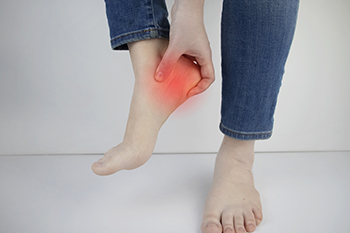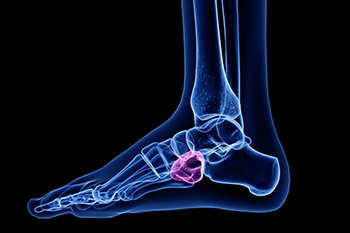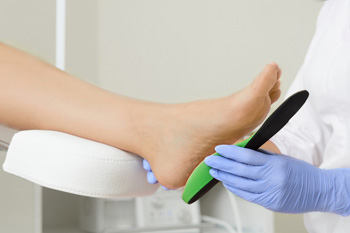Connect With Us
Blog
Items filtered by date: August 2022
Reasons Why Plantar Fasciitis May Develop

The foot condition known as plantar fasciitis occurs when the plantar fascia becomes inflamed. This is the band of tissue that is found on the sole of the foot and connects the heel to the toes. It also creates the arch in the foot. One of the first symptoms of plantar fasciitis is heel pain and it may be worse upon arising in the morning. It can develop as a result of repetitive stress that is common among runners, or it may happen from overstretching. People who have flat feet or high arches may be prone to developing this condition, in addition to being obese or pregnant. It may also happen from wearing shoes that do not fit correctly. The symptoms that many people have can consist of severe pain, swelling, and redness in the heel area, and it may be difficult to walk. If the condition is mild, relief may be found when specific stretches are performed. Additionally, custom-made orthotics may be worn so daily activities can be completed with little or no pain. For severe cases, surgery may be necessary for permanent relief. If you have heel pain, it is advised that you seek counsel from a podiatrist who can properly diagnose plantar fasciitis and offer you the correct treatment options.
Plantar fasciitis can be very painful and inconvenient. If you are experiencing heel pain or symptoms of plantar fasciitis, contact Jeffrey L. Bober, DPM from Maryland. Our doctor can provide the care you need to keep you pain-free and on your feet.
What Is Plantar Fasciitis?
Plantar fasciitis is the inflammation of the thick band of tissue that runs along the bottom of your foot, known as the plantar fascia, and causes mild to severe heel pain.
What Causes Plantar Fasciitis?
- Excessive running
- Non-supportive shoes
- Overpronation
- Repeated stretching and tearing of the plantar fascia
How Can It Be Treated?
- Conservative measures – anti-inflammatories, ice packs, stretching exercises, physical therapy, orthotic devices
- Shockwave therapy – sound waves are sent to the affected area to facilitate healing and are usually used for chronic cases of plantar fasciitis
- Surgery – usually only used as a last resort when all else fails. The plantar fascia can be surgically detached from the heel
While very treatable, plantar fasciitis is definitely not something that should be ignored. Especially in severe cases, speaking to your doctor right away is highly recommended to avoid complications and severe heel pain. Your podiatrist can work with you to provide the appropriate treatment options tailored to your condition.
If you have any questions please feel free to contact our office located in Glen Burnie, MD . We offer the newest diagnostic and treatment technologies for all your foot and ankle needs.
Several Reasons Why Cuboid Syndrome May Develop

People who experience pain on the outside of the foot may have cuboid syndrome. This foot condition can follow an ankle sprain and may be difficult to diagnose. It can be common among ballet dancers and can result due to the style of dance they perform. The cuboid bone is one of seven tarsal bones and lies beneath the fourth and fifth toes. If this becomes moved from gradual overuse or an injury, it may become inflamed, referred to as cuboid syndrome. Additional causes of developing cuboid syndrome can include training on uneven surfaces, lack of adequate support from wearing the wrong shoes, or possibly excessive pronation. Some people have intermittent pain and there can be tenderness along the outside of the foot which may be similar to having an ankle injury. There are various treatment options for this condition and it is strongly advised that you are under the care of a podiatrist who can determine the best course of treatment for you.
Cuboid syndrome, also known as cuboid subluxation, occurs when the joints and ligaments near the cuboid bone in the foot become torn. If you have cuboid syndrome, consult with Jeffrey L. Bober, DPM from Maryland. Our doctor will assess your condition and provide you with quality foot and ankle treatment.
Cuboid syndrome is a common cause of lateral foot pain, which is pain on the outside of the foot. The condition may happen suddenly due to an ankle sprain, or it may develop slowly overtime from repetitive tension through the bone and surrounding structures.
Causes
The most common causes of cuboid syndrome include:
- Injury – The most common cause of this ailment is an ankle sprain.
- Repetitive Strain – Tension placed through the peroneus longus muscle from repetitive activities such as jumping and running may cause excessive traction on the bone causing it to sublux.
- Altered Foot Biomechanics – Most people suffering from cuboid subluxation have flat feet.
Symptoms
A common symptom of cuboid syndrome is pain along the outside of the foot which can be felt in the ankle and toes. This pain may create walking difficulties and may cause those with the condition to walk with a limp.
Diagnosis
Diagnosis of cuboid syndrome is often difficult, and it is often misdiagnosed. X-rays, MRIs and CT scans often fail to properly show the cuboid subluxation. Although there isn’t a specific test used to diagnose cuboid syndrome, your podiatrist will usually check if pain is felt while pressing firmly on the cuboid bone of your foot.
Treatment
Just as the range of causes varies widely, so do treatments. Some more common treatments are ice therapy, rest, exercise, taping, and orthotics.
If you have any questions, please feel free to contact our office located in Glen Burnie, MD . We offer the newest diagnostic and treatment technologies for all your foot care needs.
Orthotics for Overpronation

Orthotics are shoe inserts that can be recommended to correct problems in your gait or the structure of your feet. Overpronation is one kind of gait issue that can potentially be corrected with the use of orthotics. An individual has overpronation when their feet excessively roll inward during walking or running for shock absorption purposes. Overpronation ultimately puts unnecessary pressure both on the big toe and on the entire inner foot. To correct overpronation before it leads to other complications, you might use orthotics. Custom-made orthotics that are specifically fit to your foot type may be able to restrict the extent to which your foot rolls inward through arch support padding. To reduce strain on your ankle from overpronation, orthotics can redistribute and reallocate the pressure you put on your feet. Orthotics might even have heel wedges to restrict how much the heel moves forward when the feet are in motion. However, it is important to note that in some cases orthotics alone might not completely correct and eliminate your overpronation. If you have overpronation and are interested in possibly using orthotics, contact your podiatrist for help.
If you are having discomfort in your feet and would like to try orthotics, contact Jeffrey L. Bober, DPM from Maryland. Our doctor can provide the care you need to keep you pain-free and on your feet.
What Are Orthotics?
Orthotics are inserts you can place into your shoes to help with a variety of foot problems such as flat feet or foot pain. Orthotics provide relief and comfort for minor foot and heel pain but can’t correct serious biomechanical problems in your feet.
Over-the-Counter Inserts
Orthotics come in a wide variety of over-the-counter inserts that are used to treat foot pain, heel pain, and minor problems. For example, arch supports can be inserted into your shoes to help correct overarched or flat feet, while gel insoles are often used because they provide comfort and relief from foot and heel pain by alleviating pressure.
Prescription Orthotics
If over-the-counter inserts don’t work for you or if you have a more severe foot concern, it is possible to have your podiatrist prescribe custom orthotics. These high-quality inserts are designed to treat problems such as abnormal motion, plantar fasciitis, and severe forms of heel pain. They can even be used to help patients suffering from diabetes by treating foot ulcers and painful calluses and are usually molded to your feet individually, which allows them to provide full support and comfort.
If you are experiencing minor to severe foot or heel pain, it’s recommended to speak with your podiatrist about the possibilities of using orthotics. A podiatrist can determine which type of orthotic is right for you and allow you to take the first steps towards being pain-free.
If you have any questions please contact our office located in Glen Burnie, MD . We offer the newest diagnostic and treatment technologies for all your foot and ankle needs.
Toe Lesions

Individuals may experience pain in the toes for a multitude of different reasons. For example, toe pain may arise from problems in the bones or calluses that formed on the outside of the toes. One condition that can cause toe pain is known as lesions. These can develop on more than one toe, and sometimes on both feet. Lesions can cause pain during the day and create an extremely uncomfortable itching sensation throughout the night. Another important sign of lesions on the toes is swelling around the affected area and discoloration, which can essentially turn the toe into a purple tint. What can make toe lesions all the more troubling and uncomfortable is that wearing anything on the feet, from socks to shoes, can be extremely painful. Chilblains, a related condition, usually develop on the feet when blood vessels become inflamed as a result of exposure to cold temperatures. Some cases of toe lesions have also been identified in individuals who have tested positive for COVID-19, although any kind of definitive, causal relationship between the two conditions remains to be seen. If you think that you are suffering from toe lesions, consider reaching out to a podiatrist.
Toe pain can disrupt your daily activities. If you have any concerns, contact Jeffrey L. Bober, DPM of Maryland. Our doctor can provide the care you need to keep you pain-free and on your feet.
What Causes Toe Pain?
Most severe toe pain is caused due to a sports injury, trauma from dropping something heavy on the toe, or bumping into something rigid. Other problems can develop over time for various reasons.
Toe pain can be caused by one or more ailments. The most common include:
- Trauma
- Sports injury
- Wearing shoes that are too tight
- Arthritis
- Gout
- Corns and calluses
- Hammertoe
- Bunions
- Blisters
- Ingrown toenails
- Sprains
- Fractures (broken bones)
- Dislocations
When to See a Podiatrist
- Severe pain
- Persistent pain that lasts more than a week
- Signs of infection
- Continued swelling
- Pain that prevents walking
Diagnosis
In many cases the cause of toe pain is obvious, but in others, a podiatrist may want to use more advanced methods to determine the problem. These can range from simple visual inspections and sensation tests to X-rays and MRI scans. Prior medical history, family medical history, and any recent physical traumatic events will all be taken into consideration for a proper diagnosis.
Treatment
Treatments for toe pain and injuries vary and may include shoe inserts, padding, taping, medicines, injections, and in some cases, surgery. If you believe that you have broken a toe, please see a podiatrist as soon as possible.
If you have any questions please feel free to contact our office located in Glen Burnie, MD . We offer the newest diagnostic tools and technology to treat your foot and ankle needs.
Arthritis Can Cause Pain in the Feet and Ankles
When Sports Footwear Causes Pain on the Top of the Foot

There are thin tendons on the top of your feet that connect your toes with muscles in the front of the lower leg. These are called extensor tendons. Extensor tendons help you flex your feet and raise your toes. Because they reside just underneath the skin on the top of the feet and have no padding, they are susceptible to becoming injured, inflamed, and painful. This is known as extensor tendonitis. Extensor tendonitis can sometimes be caused by overuse, or from shoes that are too tight. Dancers, runners, skiers, and skaters are susceptible to developing extensor tendonitis because they wear shoes that lace tightly in the front which can press hard against these tendons. In this way, extensor tendonitis is sometimes a sports-related injury. Extensor tendonitis can be diagnosed and treated by a podiatrist who may need to analyze imaging tests to rule out other injuries and make sure no other damage has been done to surrounding structures. It is suggested you consult with your podiatrist for shoe modifications, stretching, and strengthening exercises, and they may prescribe anti-inflammatory drugs, suggest icing, or even prescribe steroid therapy. In very severe cases, surgery may be necessary to repair the extensor tendons.
Ankle and foot injuries are common among athletes and in many sports. They can be caused by several problems and may be potentially serious. If you are feeling pain or think you were injured in a sporting event or when exercising, consult with Jeffrey L. Bober, DPM from Maryland. Our doctor will assess your condition and provide you with quality foot and ankle treatment.
Common Injuries
The most common injuries that occur in sporting activities include:
- Achilles Tendonitis
- Achilles Tendon Rupture
- Ankle Sprains
- Broken Foot
- Plantar Fasciitis
- Stress Fractures
- Turf Toe
Symptoms
Symptoms vary depending upon the injury and in some cases, there may be no symptoms at all. However, in most cases, some form of symptom is experienced. Pain, aching, burning, bruising, tenderness, tightness or stiffness, sensation loss, difficulty moving, and swelling are the most common symptoms.
Treatment
Just as symptoms vary depending upon the injury, so do treatment options. A common treatment method is known as the RICE method. This method involves rest, applying ice, compression and elevating the afflicted foot or ankle. If the injury appears to be more serious, surgery might be required, such as arthroscopic or reconstructive surgery. Lastly, rehabilitation or therapy might be needed to gain full functionality in the afflicted area. Any discomfort experienced by an athlete must be evaluated by a licensed, reputable medical professional.
If you have any questions, please feel free to contact our office located in Glen Burnie, MD . We offer the newest diagnostic and treatment technologies for all your foot care needs.
Blog Archives
- April 2025
- March 2025
- February 2025
- January 2025
- December 2024
- November 2024
- October 2024
- September 2024
- August 2024
- July 2024
- June 2024
- May 2024
- April 2024
- March 2024
- February 2024
- January 2024
- December 2023
- November 2023
- October 2023
- September 2023
- August 2023
- July 2023
- June 2023
- May 2023
- April 2023
- March 2023
- February 2023
- January 2023
- December 2022
- November 2022
- October 2022
- September 2022
- August 2022
- July 2022
- June 2022
- May 2022
- April 2022
- March 2022
- February 2022
- January 2022
- December 2021
- November 2021
- October 2021
- September 2021

